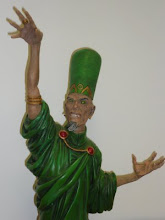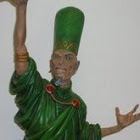 An engaging and entertaining update of a classic pulp star. Richard Wenthworth is the Spider, a masked vigilante who fights spectacular criminals in New York. When New York comes under threat from a woman calling herself Anput launches chemical attacks than turn people into zombies, the Spider becomes involved. The struggle with Anput draws in his family, friends and the woman he loves before the final revelation.
An engaging and entertaining update of a classic pulp star. Richard Wenthworth is the Spider, a masked vigilante who fights spectacular criminals in New York. When New York comes under threat from a woman calling herself Anput launches chemical attacks than turn people into zombies, the Spider becomes involved. The struggle with Anput draws in his family, friends and the woman he loves before the final revelation.A costumed crime fighter who is working to prevent his home city from falling further into corruption and ruin and who is incidentally a rich man is not exactly an original story idea. It was not one when the Spider launched in the pulps, still it was a good hook then and it remains, in the right hands, a good hook now.
David Liss takes everything that makes the Spider the same as everyone else and mixes them very effectively with everything that makes him different. The primary difference is the fact that the Spider kills his enemies, he has none of the scruples that his superhero peers have. This is explicitly presented as a choice that the Spider makes when he decided on his path, his enemies deal in death and so does he. This is ultimately the least interesting difference in the story set up as it makes the smallest difference in dramatic story terms. There are much more significant differences and all are related to the dual identity of the Spider and his role in the dynamics of the city.
Richard Wenthworth does not vanish inside the Spider when he dons the cape, it is very clearly the same person, the cape is the uniform for the job no more than that. This gives the problems that Wenthworth has in dealing with his actions as the Spider some more depth and heft, he pays a price for his on violence.
Much more interesting that this is the web of knowledge, explicit and assumed about Richard Wenthworth being the Spider. Wenthworth's ex-girlfriend knows that he is the Spider, her husband the police commissioner who feels that the Spider is useful in the city and may suspect Wenthworth and does not want to know for sure, Joe Hilt, a detective who is sure that Wenthworth is the Spider but cannot prove it and Ram Singh, Wenthworth's lawyer who does know.
This is a nice tangle that gives the story of the Spider context and depth and allows for numerous dramatic possibilities, David Liss makes uses of a lot of them. They nicely complicate the straight extortion of the Zombie Queen as the struggle whit her draws in the cast and their relationships to Wenthworth become important.
I have a very strong preference for drawn art, the art by Colton Worley is too great a mix between drawn and near photographic, the elements do not blend into a cohesive whole for me. The art tends to distract and push me out of the story rather than pulling me in and along. The colouring is excellent, in particular the Spiders cape.
Simon Bowland's lettering is very well done, it quietly and effectively makes the difference between the Spider's narration and the conversations among the cast, it gives Richard Wenthworth as the Spider a voice of his own. This is a very well written comic with strong distinctive art, well worth reading.


